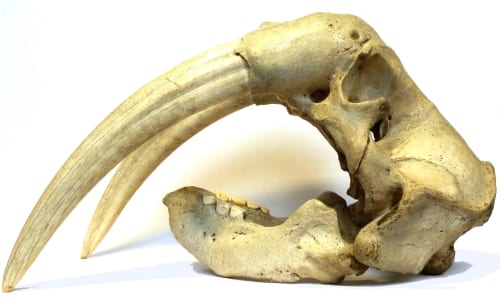Specimen of the Week 212: I am the Walrus
By ucwepwv, on 2 November 2015
After spending my Halloween weekend dressed as a vampire, I’ve been thinking a lot about animals with big fangs that feed by suction.
That’s right, my Specimen of the Week is…
**a walrus, Odobenus rosmarus **
I developed a bit of a soft spot for walruses after working at the Horniman Museum and Gardens, which has an iconic and famously over-stuffed specimen dominating the Natural History Gallery.
I hope the Horniman walrus isn’t offended by the following species diagnosis, but it reads like a description of a somewhat comical literary character:
“Body rotund, girth nearly equal to length; neck massive; head small, blocky;…”¹
And that’s missing out the thick folds of skin (absent in the overly rotund Horniman specimen) and clumsy flippers. Of course the most obvious feature of a walrus is the pair of massive tusks, which are formed from the upper canines, that have an open root which allows the tusks to keep growing throughout the animal’s life.
I always thought that the tusks weren’t used for hunting, since walruses mainly eat marine molluscs that are sucked from their shells by a powerful vacuum-like force produced in the mouth – a dietary preference alluded in Lewis Carroll’s poem The Walrus and the Carpenter.

A scene from “The Walrus and the Carpenter”, by Lewis Carroll, drawn by Sir John Tenniel in 1871. Reproduced under PD-ART-LIFE-70.
I did know that walrus tusk can act like ice-picks for hauling up on slippery ice, but mainly they are used by the males for fighting. These fights are a significant cause of mortality both for the combatants and any calves that get caught between them¹; unsurprising when you consider that a large and well-fed bull male can weigh up to two tonnes and their fights involve a couple of these behemoths head-butting each other with two-foot long ice-picks sticking out of their faces, all while galumphing around on a lump of ice with clumsy flippers.
So it’s no wonder that when you look at a walrus you can often see scars all over them from their epic battles. That’s one of the reasons for their thick rolls of skin and heavy layer of blubber, especially around their neck and chest. This is their body armour, which helps protect their more vulnerable organs, as well as providing insulation against the frigid waters of the Arctic.
What was new to me was that there are reports of walruses stabbing seals with their tusks, with evidence from gut contents that they then tear the seals into easy to swallow strips and eat them². So it turns out that these somewhat comical-looking animals are not just imposing fighters, but they have a darker, more predatory side as well. Never underestimate a walrus.
References
¹Fay, FH. 1985. Odobenus rosmarus. Mammalian Species, 238:1-7
²Lowry, LF & Fay, FH. 1984. Seal Eating by Walruses in the Bering and Chukchi Seas. Polar Biology, 3:11-18
Paolo Viscardi is the Curator of the Grant Museum of Zoology
One Response to “Specimen of the Week 212: I am the Walrus”
- 1
 Close
Close




[…] More mystery objects to come from the Grant next week, but if you’d like to see another specimen from the collection, my latest specimen of the week that looks at the darker side of the Walrus might be of interest. […]